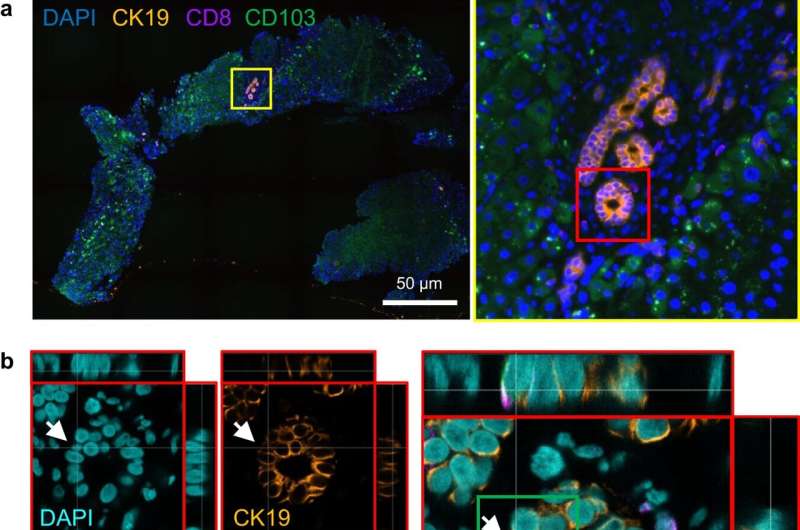This article has been reviewed according to Science X's editorial process and policies. Editors have highlighted the following attributes while ensuring the content's credibility:
fact-checked
trusted source
proofread
Research into autoimmune liver condition suggests unique cell movements may drive disease

Research suggests that a recent understanding of cell movements may help shed light on the mechanisms driving primary biliary cholangitis (PBC), an autoimmune disease that attacks the bile ducts of the liver.
According to a recent paper published in Nature Communications, Dr. Scott Davies, Professor Ye Htun Oo and the team found that the invasion mechanism of cytotoxic cells, known as CD8+T cells, was different to that of other cell-in-cell movements in the liver.
They discovered that these T cells can re-arrange their cytoskeletons in order to invade the biliary epithelial cells (BEC) which has been associated with biliary damage.
The study was made possible through generous donations of human liver tissue from patients at the Liver Unit of the Queen Elizabeth Hospital, Birmingham, U.K. Researchers devised innovative experimental approaches using high-content imaging, allowing for many conditions to be analyzed simultaneously.
Dr. Scott Davies, Professor Ye Htun Oo and the team are hopeful that this research will open up new avenues for understanding and potentially treating this debilitating autoimmune condition, as well as providing broader implications into the behavior of these cells in autoimmune diseases afflicting other parts of the body.
He says, "Further understanding of how CD8+ T cells acquire E-cadherin and the consequences of these cells entering BECs may provide new insights into the causes of PBC and lead to the development of novel treatment strategies."
Primary biliary cholangitis (PBC) is a type of liver disease where the immune system attacks the bile ducts of the liver, leading to the bile ducts becoming damaged and causing bile to build up in the liver. This further damages the liver and may lead to scarring. Common symptoms of PBC include fatigue, bone and joint aches and pain or discomfort in the upper right abdomen. Approximately 20,000 people in the U.K. are affected.
In this particular study, the team identified a crucial protein, E-cadherin, as a key player in this cell-in-cell movement process. E-cadherin is typically expressed by BECs and similar cells to maintain tissue integrity. However, the researchers found that CD8+ T cells from PBC patients expressed higher levels of E-cadherin compared to those from non-PBC patients, suggesting a link between E-cadherin levels and the increased internalization of T cells in PBC. This discovery holds significant implications for understanding the pathogenesis of PBC.
More information: Scott P. Davies et al, Expression of E-cadherin by CD8+ T cells promotes their invasion into biliary epithelial cells, Nature Communications (2024). DOI: 10.1038/s41467-024-44910-2




















